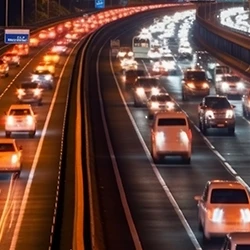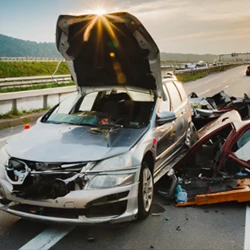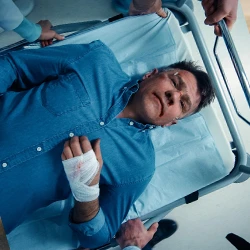Navigating the bustling streets of Los Angeles can be a daunting task, even for seasoned drivers. With seemingly endless traffic and a myriad of potential hazards, it's no wonder LA has a reputation for being a challenging city to drive in.
But, armed with knowledge of "the most dangerous times to drive in LA" and places, you can avoid the worst traffic in Los Angeles.
Leveraging my legal background and experience, my focus as an attorney goes beyond helping car accident victims; it's primarily about preventing accidents. I've analyzed traffic data to provide vital insights into dangerous driving times in Los Angeles.
Quick Summary
What Are the Most Dangerous Times to Drive in LA?

Morning Rush Hour
Morning rush hour in Los Angeles generally occurs between 7 AM and 10 AM, when commuters flood the roads to reach their workplaces or educational institutions [2]. During this time, the limited access highway and surface streets alike experience heightened rush hour traffic, increasing the risk of a serious accident.Exact hours
: 7 AM - 10 AM, with the heaviest traffic from 7:30 AM to 9:00 AM
Specific risk factors include:
- Congested roads
- Tired or distracted drivers
- Sudden lane changes
- Tailgating
To avoid being stuck in traffic here are alternative solution:
- Use surface streets, especially on Mondays and Fridays
- Consider public transportation options
California drivers should be particularly vigilant during these hours, as the combination of congested roads and tired or distracted drivers can result in a higher likelihood of motor vehicle collisions.Also Read
Evening Rush Hour

4 PM - 7 PM, with worst traffic from 5:00 PM to 7:00 PM
Specific risk factors:
- Congested roads
- Aggressive driving
- Road rage incidents
- Driver fatigue
To avoid the traffic, here are smart alternatives for a smoother ride:
- Consider that Monday evenings typically have the best traffic flow
- Use alternative surface streets when possible
Reducing the risk of accidents during the evening rush hour necessitates:
- Focus and evasion of distractions such as cell phones or eating while driving
- Maintaining a safe following distance
- Be prepared for any sudden stops or changes in traffic conditions
- Pay attention to distracted or aggressive drivers to react more quickly to potential hazards.
Weekend Nights

Heaviest traffic on Saturday afternoons and evenings
Specific risk factors:
- Impaired drivers (alcohol, drugs)
- Unfamiliar routes for tourists and visitors
- Increased pedestrian activity in entertainment districts
Alternative routes:
- Avoid popular tourist attractions and nightlife areas
- Use local roads and less congested streets
Special Events and Holidays
Special events and holidays in Los Angeles can lead to increased Los Angeles traffic and a higher risk of accidents due to unfamiliar drivers, road closures, and a surge in pedestrian activity. Caution, pre-planning your route, and patience while navigating congested roads become important during these times.By being aware of potential hazards and staying vigilant, you can help ensure a safer driving experience during special events and holidays.Exact hours:
Vary by event, check local announcements
Specific risk factors:
- Road closures and detours
- Increased pedestrian activity
- Unfamiliar drivers and tourists
- Potential for impaired driving during holidays
Alternative routes:
- Plan ahead using traffic apps and local news
- Consider public transportation for major events
Most Common Areas for Auto Accidents in LA

Major freeway junctions, busy intersections, and areas with high pedestrian traffic are common sites for collisions in Los Angeles County [4].
Highways to avoid in Los Angeles include the I-405, I-10, and US-101, especially during peak traffic hours.
The following are also other areas that are common for auto accidents:
These highways tend to experience high congestion levels and are more likely to see accidents, making them potentially dangerous for drivers.To ensure safety in these high-risk areas, obeying traffic laws, maintaining a safe following distance, and staying alert to the actions of other drivers and pedestrians are required. By being proactive and anticipating potential hazards, you can help reduce the likelihood of an accident in these high-risk locations.
Most Common Causes Of Auto Accidents in LA
Most car accidents happen in Los Angeles because of:
- Aggressive driving
- Speeding
- Distracted driving
- Driving under the influence
These behaviors not only put the drivers themselves at risk but also endanger other motorists and pedestrians on the road.
"Car accidents in Los Angeles have seen a 29 percent rise in the past four years, in contrast to the 12 percent increase seen nationwide."
- The California Highway Patrol
Legal Considerations for Driving in Los Angeles in 2024
The steps you take immediately after an accident can have a significant impact on the outcome of your case, from the police report to the collection of evidence. Here’s what you should do if you find yourself involved in a car accident in Los Angeles in 2024:
- Seek medical attention immediately, even if injuries seem minor: Some injuries, such as whiplash or internal injuries, may not be immediately apparent. Prompt medical evaluation is essential.
- Contact the police to generate a Traffic Collision Report: A police report is crucial for insurance claims and any potential legal actions.
- Document the accident scene with photos and videos: Take clear pictures of the vehicles, the surrounding area, and any visible damages or injuries.
- Collect contact information from all parties involved and witnesses: This includes names, phone numbers, and insurance details.
- Avoid discussing fault or making statements about the accident: Anything you say at the scene could be used against you later. Stick to the facts.
- Contact an experienced accident attorney for legal guidance: A skilled lawyer can help navigate the complexities of the legal system and maximize your chances of receiving fair compensation.
What To Do If You Are Injured in a California Car Accident?

In addition to seeking medical treatment, gather as much evidence as possible from the accident scene, including photographs, contact information of witnesses, and a copy of the police report. Then, consult with a car accident attorney to discuss your case and explore your options for filing a claim and seeking compensation for your injuries.
Related Article: Cell Phone Driving Laws by California
FAQs
What Is The Best Time To Drive Through LA To Avoid Traffic?The best times to drive through LA to avoid traffic are typically during non-rush hours, which are usually mid-morning between 10 AM and noon and early afternoon between 1 PM and 3 PM. Additionally, weekends tend to have lighter traffic compared to weekdays.Where Do Most Car Accidents Happen In LA?Most car accidents happen in LA in busy intersections such as Hollywood and Highland, Crenshaw and Martin Luther King Jr. Boulevards, and the 101 and 405 freeway interchange. What Highways To Avoid In Los Angeles?Highways to avoid in Los Angeles are the 405 and 101 freeways. Opt for alternative routes or consider using navigation apps to find less congested paths.
File Your Claim Today With a Car Accident Attorney
At Schmidt & Clark, LLP we're here to support you when it matters most. If you or a loved one seek guidance after an accident or injury on the road, don't hesitate to reach out. Our team possesses in-depth knowledge of road safety in Los Angeles, and we're ready to assist you at every stage.We believe in your right to understand your options and the potential for any legal actions. Our consultations are always free, and you'll only pay if we secure a favorable outcome for your case. We're dedicated to serving you with the same care and commitment we would provide to our own loved ones.
References:
- https://injuryfacts.nsc.org/motor-vehicle/overview/crashes-by-time-of-day-and-day-of-week/
- https://repositorio.cepal.org/server/api/core/bitstreams/d0851342-86b1-4aee-a262-0bedb95193cc/content
- https://discovery.ucl.ac.uk/id/eprint/1428/1/Sandy_Nighttime_accidents_Full_Report.pdf
- https://www.sciencedirect.com/science/article/pii/S2185556020300031

 Published by
Published by